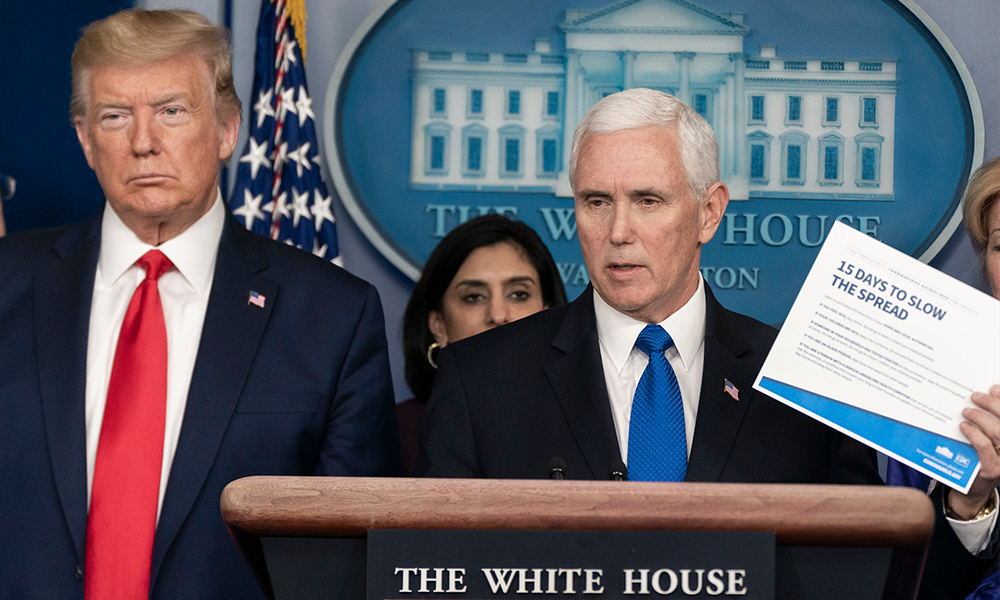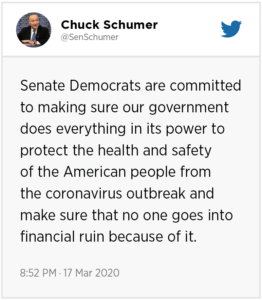March 23, 2020
March Madness: COVID-19 Changes the Game


The following is an excerpt from the March 20, 2020, Federal Budget IQ monthly report. Over the weekend of March 21-22, congressional and White House negotiations continued and, as we predicted, the funding level of the coronavirus response and economic stimulus package grew substantially and congressional leaders struggled to find bipartisan agreement.
On March 11th, World Health Organization (WHO) Director-General Ghebreyesus “made the assessment that COVID-19 can be characterized as a pandemic.”
Congress responded quickly with an initial $8.3 billion emergency supplemental aimed primarily at supporting state and local government efforts to slow the spread of the virus. A second $100 billion bill, H.R. 6201, the Families First Coronavirus Response Act, was negotiated by Speaker Pelosi (D-CA) and Treasury Secretary Mnuchin to strengthen social safety net programs. This bill ensured food assistance for elderly and low-income Americans, created a temporary emergency sick leave program, made no cost COVID-19 testing available, and provided more financial relief to state and local governments by increasing federal medical assistance support to states. H.R. 6201 passed the House (363-40) and the Senate (90-8) with broad bipartisan support.
COVID-19 has been a game-changer. In October, the World Bank forecast predicted a global economic slowdown for 90% of the world. The Federal Reserve and blue-chip forecasters predicted U.S. GDP growth of 2%. The glaring absence of a coordinated global response to the COVID-19 pandemic alters those forecasts.
We now face a global contraction of 5% or more for at least two quarters with a shallower U.S. recession. As we previously discussed, historically low interest rates and the Fed’s protracted quantitative easing regime limit the recession-fighting tools available to central banks. The Federal Reserve Board cut the federal funds rate to zero, and the record 11-year bull market run ended.
Over the past week, life in America has changed. State and local governments and businesses have issued guidance to work remotely where possible to slow the spread of the virus. Schools halted in-person instruction. Restaurants and gyms closed. The combination has strained network capacity in residential areas. While no one can say with certainty when things will return to normal, March 18th marked the first day since the outbreak began that no new domestic COVID-19 infections were reported in China.
On March 13th, President Trump declared a national emergency releasing $50 billion in emergency funding to assist state and local governments in the fight against COVID-19.
On March 16th, Senate Majority Leader McConnell (R-KY) announced, “we are not leaving town until we have constructed and passed another bill. We will stay here until we reach a bipartisan agreement and at least 60 votes to pass it. We are going to move here in warp speed, for the Senate.”
Congressional Republicans and Democrats are now discussing a $1 trillion Stage 3 economic stimulus package that McConnell introduced on March 19th. The bill could easily grow by hundreds of billions of dollars. Senate Democratic Leader Schumer (D-NY) announced his own $750 billion plan. Given the size, scope and complexity of those discussions, action on a bipartisan agreement is unlikely before next week.
Spending for federal agencies will increase significantly above our baseline 4% forecast for FY20 with that surge extending through at least the first quarter of FY21. For front-line agencies like the Centers for Disease Control, the National Institutes of Health, other HHS programs, FEMA, the Department of Homeland Security, the Department of Veterans Affairs, and the Department of Defense, those numbers will increase significantly. On March 17th, the Trump Administration submitted a $45.8 billion FY20 emergency supplemental request to Congress that also included FY21 budget amendments that increase requested FY21 funding for the Centers for Disease Control by $1.3 billion and NIH’s National Institute of Allergy and Infectious Disease (NIAID) by $0.4 billion. This is the operational part of the federal government’s COVID-19 response and it will remain the focus of FBIQ’s work. Although elements of the Administration’s plan are controversial, the price tag on the package we expect Congress to approve will increase substantially.
On March 18th, President Trump invoked the Defense Production Act, giving him the authority to direct U.S. industrial capacity to manufacture needed supplies—ventilators, protective gear for medical workers and first responders, etc.
Politically, there are big differences between the COVID-19 response and the response to the 2008-9 financial crisis. In 2008-9, the first step—the $700 billion 2008 Emergency Economic Stabilization Act—necessarily focused on Wall Street. At its core, the second step—the $787 billion American Recovery and Reinvestment Act (ARRA)—supported state and local governments. That bill didn’t create jobs as much as it reduced additional lay-offs by eliminating state matching requirements and supplementing the coffers of state and local governments with balanced budget requirements.
A review of the ARRA is instructive. Of the $387 billion it included in appropriations, roughly 85% funded a combination of grants, loan subsidies and guarantees, and state, local, and tribal construction projects. Eleven percent of the funds supported maintenance and construction of federal facilities including $5.5 billion for the GSA Federal Buildings Fund. The remaining 4% supported federal agency operations. Within that portion, the largest projects included $2 billion for HHS Health IT, $1 billion for the 2010 Census, $1 billion for TSA explosive detection equipment, and $500 million each for modernization and disability claims processing improvements at the Social Security Administration.


Secretary Mnuchin and Congressional negotiators appear to be following a similar playbook.
The pandemic response will focus on public health and Main Street first. We saw that in the initial supplemental and the bipartisan Families First Coronavirus Response Act, where the biggest budget impact was due to tax credits tied to family leave. Like ARRA, we expect a significant share of federal funding to support state and local government activities. Unlike ARRA, there will be much larger sums devoted to emergency public health and enhancing the government’s ability to respond to future crises. And, there could be a larger role for the Department of Defense both internationally, with measures to protect overseas defense personnel, and domestically, with access to military (and potentially VA) facilities to boost hospital bed capacity, critical supplies (ventilators, protective gear, etc.) and mobilization of the National Guard.
The short-term federal response to the COVID-19 pandemic aims to increase the capacity of our health care system and provide financial support for state and local government, workers and industries, as well as support strained supply chains for critical supplies. This experience should accelerate demand for increased network and critical infrastructure resilience, a trend FBIQ identified last summer that will improve America’s ability to respond to future climate, economic, health, and national security threats.